Rickubis Bird
Page #1: Wading and Mudflat
Birds(those that don't have their own page yet)!
This page was born
04/06/2004. Rickubis designed it. (such as it is.) Last
update: 02/15/2025
Images and contents on this
page copyright ©2002-2025 Richard M. Dashnau
Go
back to my home page, Welcome to rickubis.com
Go back to the RICKUBISCAM
page.
----------------------------------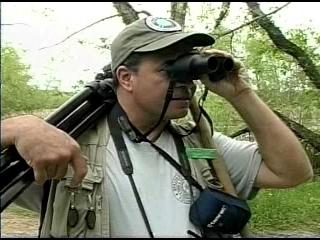
Welcome to Brazos Bend State
Park. That's me on the trail. One of the most popular reasons for
people to visit BBSP is to see the birds. Although *I* started
going to the park
mainly for the alligators, one cannot be there for long without
learning to enjoy the birds. Over the years, I've captured a few
pictures and video clips of them, and here they are.
01/21/2024
It was cold again at BBSP. When I checked the temperature
at the Forty Acre Parking Lot, it was 39.2°F, almost the same as the
previous
weekend. But the air on this
day was very damp. This damp air, when moving, can draw the heat right
out of me. It's always colder down near the Observation Tower, mostly
because of the wind blowing off of Pilant Lake. The morning was
overcast, and the air was hazy--which is further indication of hold
cold it would feel. Another
temperature
reading from that area showed 39.3°F. But this time there was the wind
off of Pilant Lake.

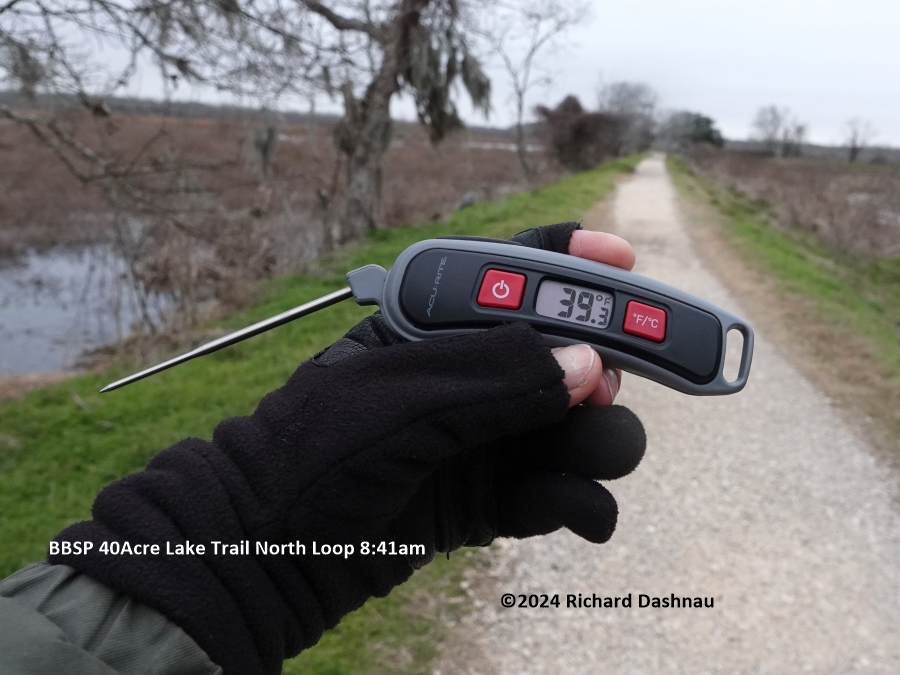
I
walked to Elm Lake, and then North to New Horseshoe lake. It's not
evident from this article,but there were many amazing birds active all
around while I walked, even
with the cold. I took a few more temperature readings at New
Horseshoe lake, then tuned back.Heading
back on the East Loop of the 40Acre Lake trail, I saw these ducks
when I looked towards the T-pier. They were Blue-winged Teal (Spatula discors) swimming with a
pair of Ring-necked Ducks (Aythya
collaris). I'm terrible at identifying
ducks, and have to look up their names almost every time. After
that, it was time to go get warm!!
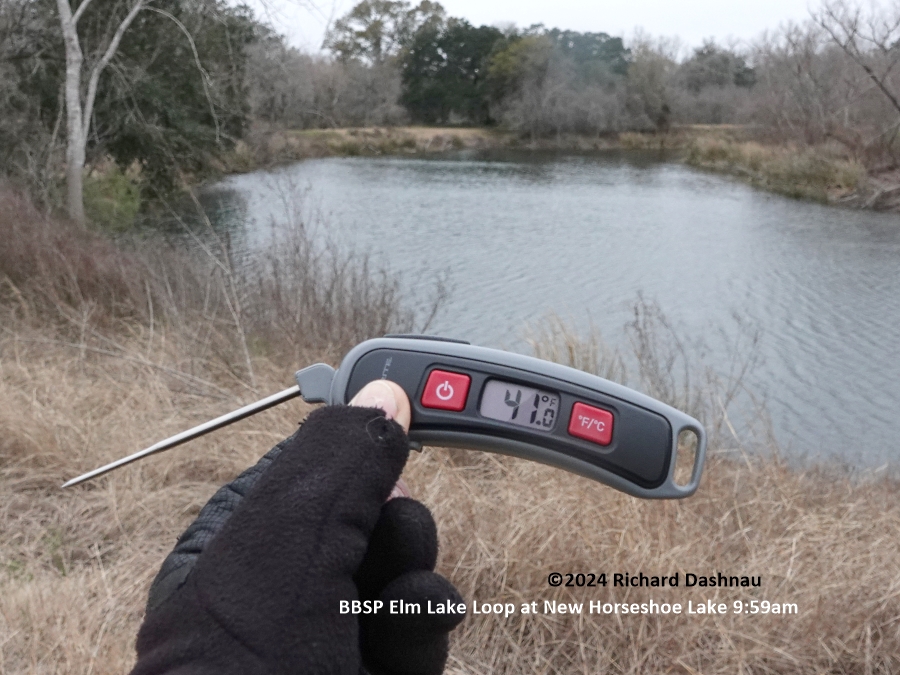
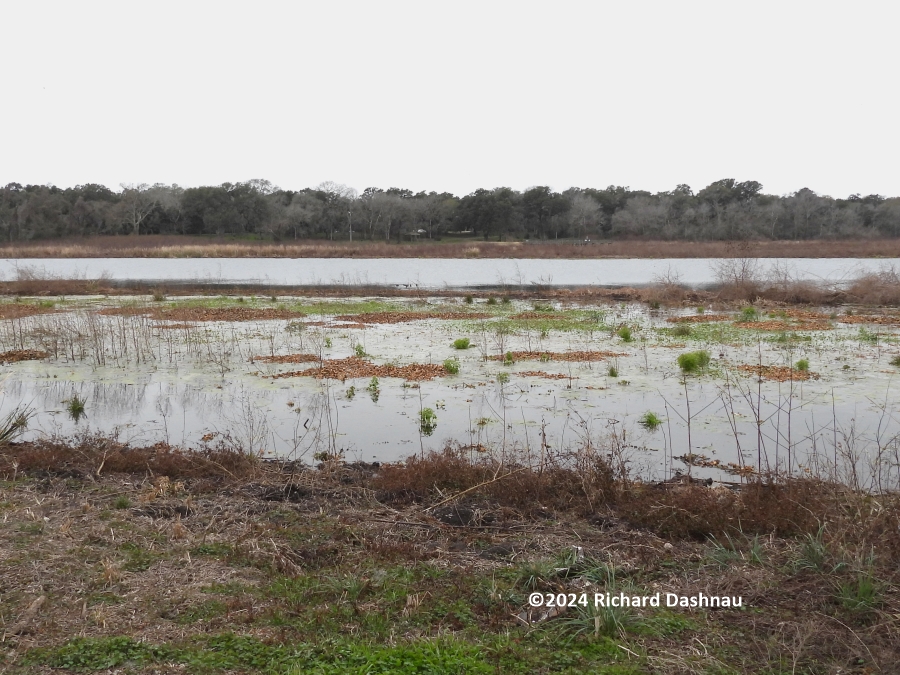

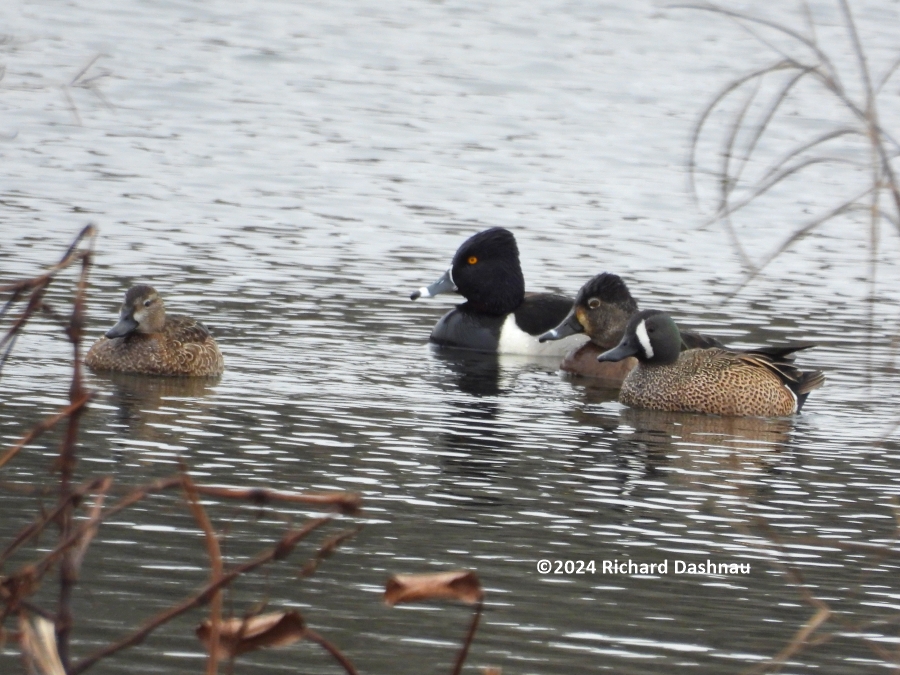
07/03/2022
If it seems depressing to see the water levels dropping...well,
it was. But these birds were also foraging in and around Pilant
Lake on July 3rd, and that was fine; so I'm including the images
here. There are some short video clips that show
their activities also, which can be seen here. When the mudflats formed
from the shallow water, we had many Black-necked Stilts come in,
and
some nested at the the lake. This is an adult with chicks.
This was the beginning of the drought I describe on this page.
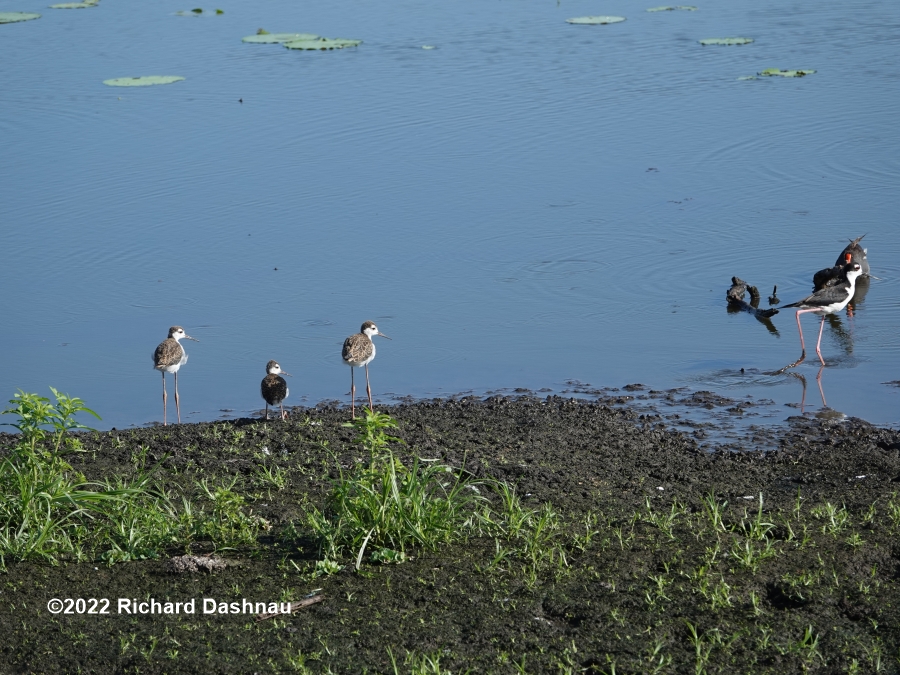
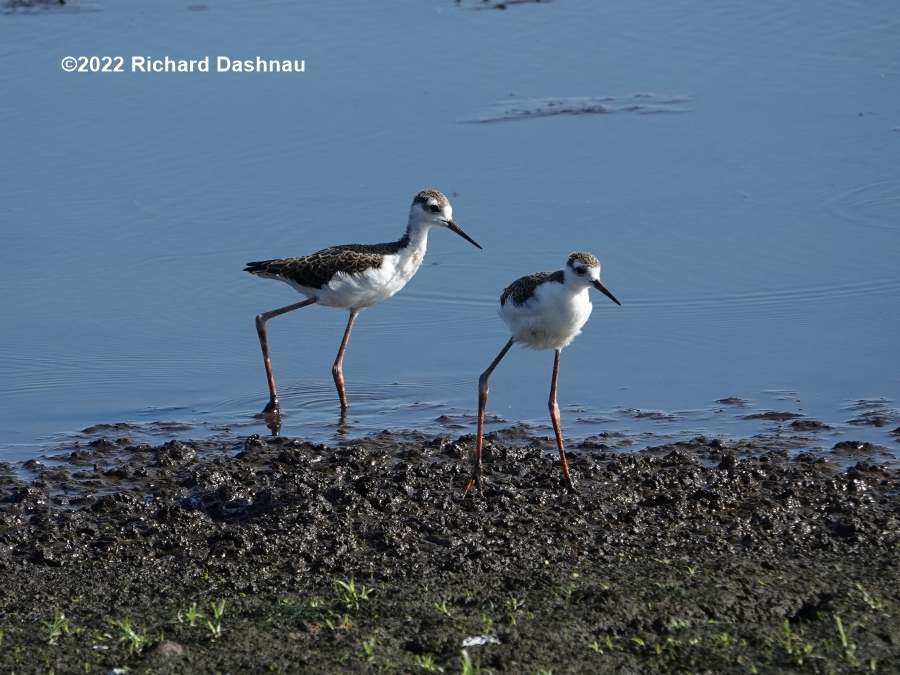
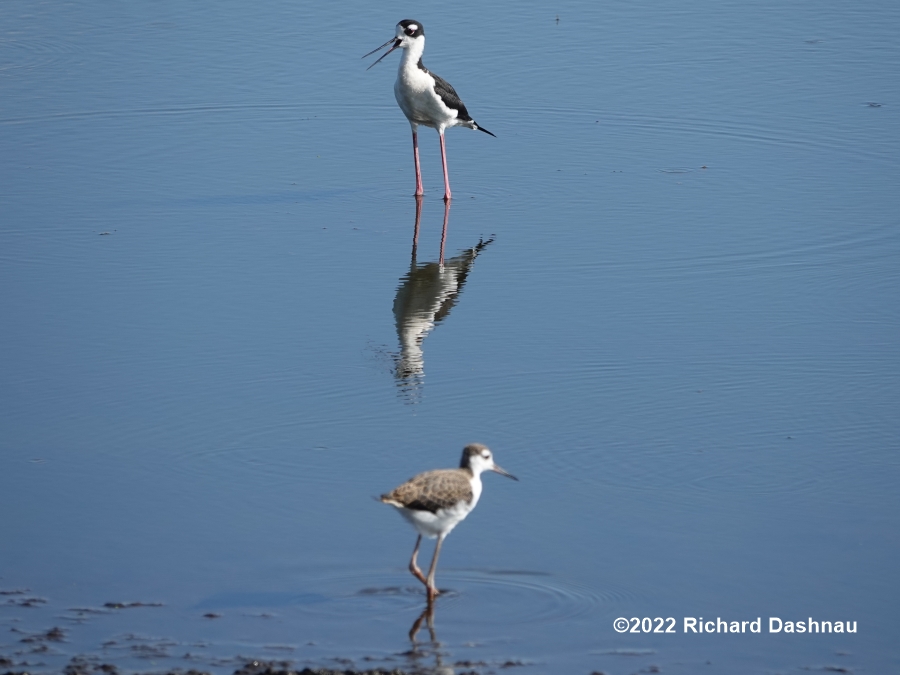
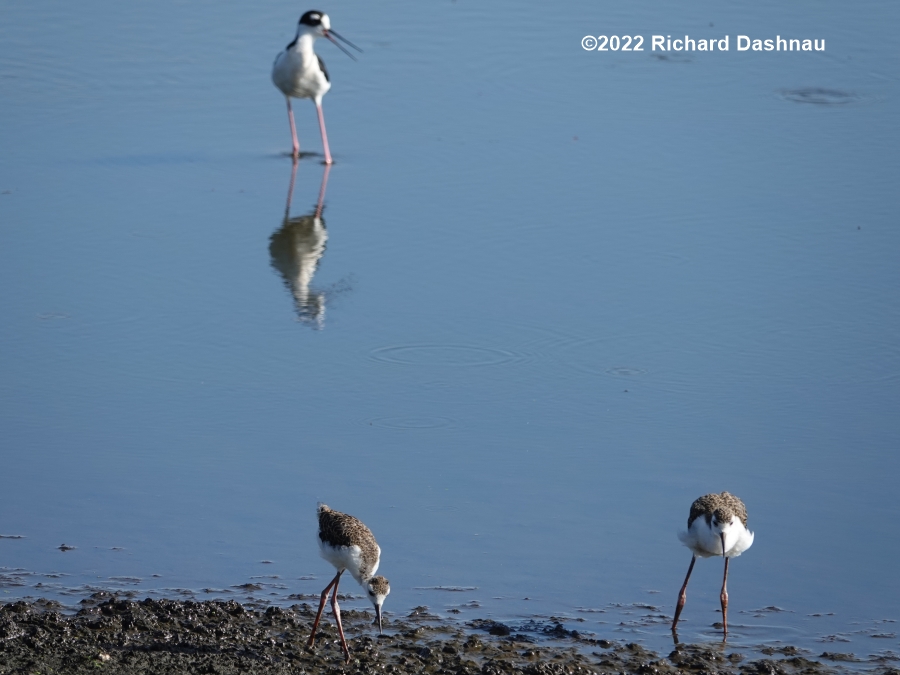
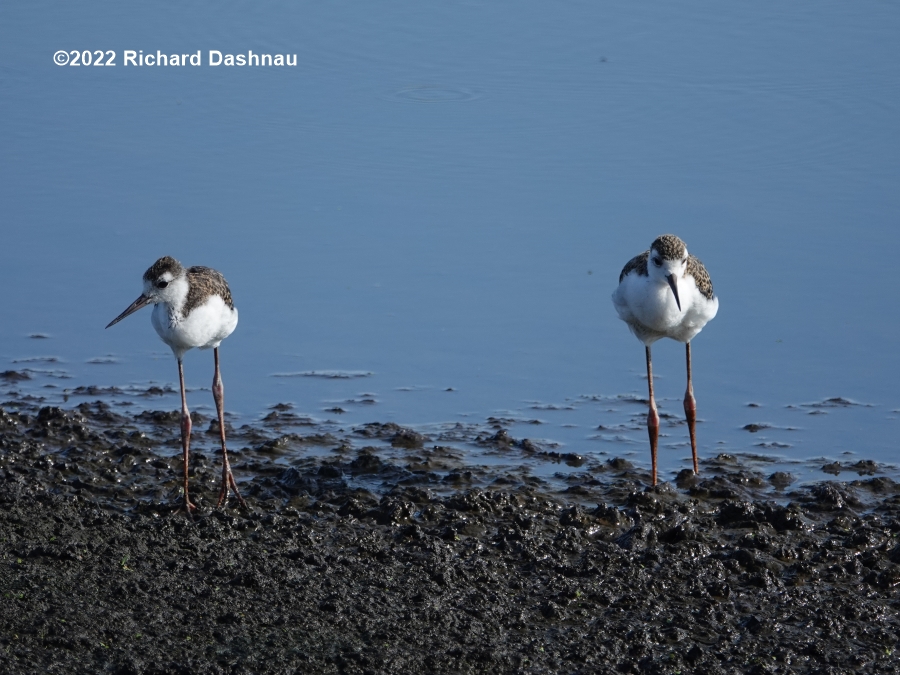
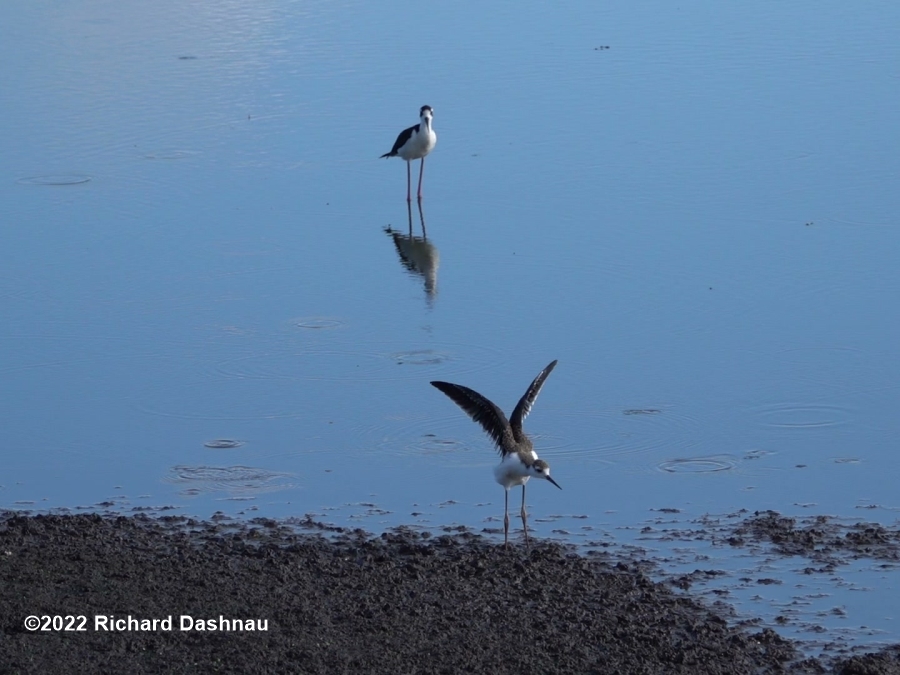
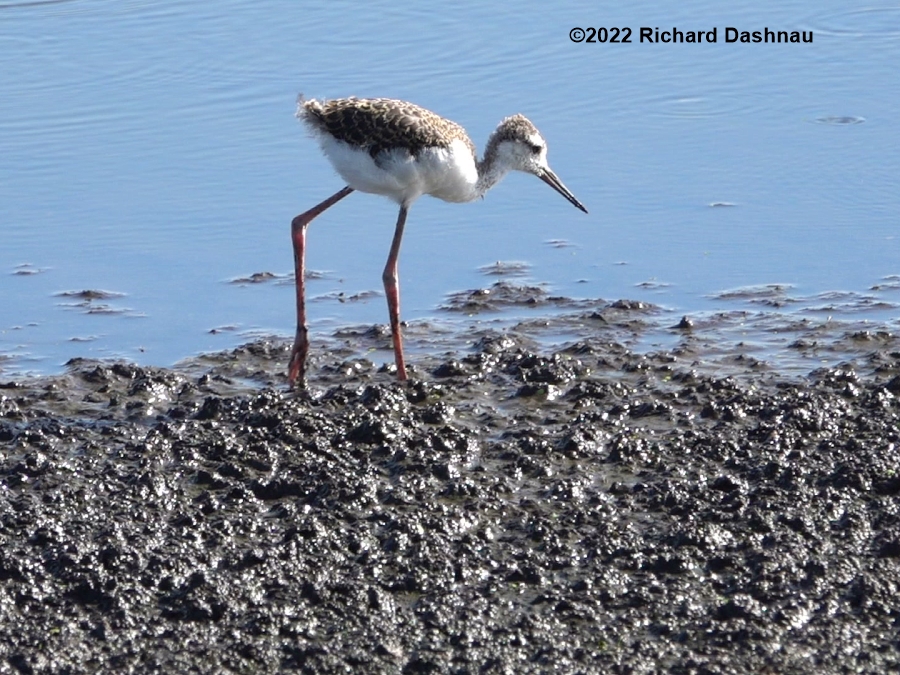
02/27/2022.
Later, I saw these beautiful Green-Winged Teal at
Creekfield Lake at 2:41pm.
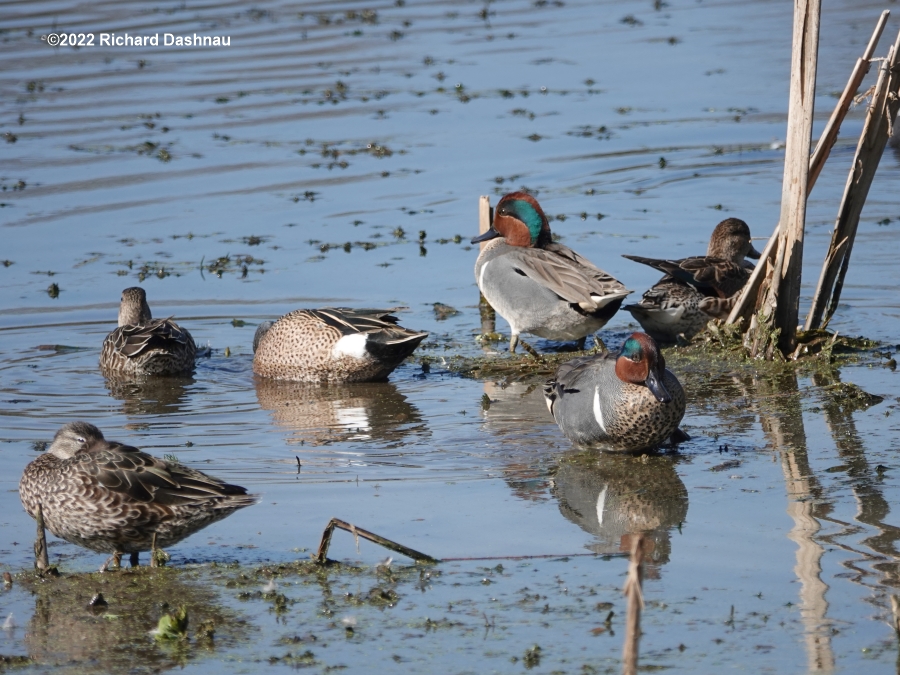
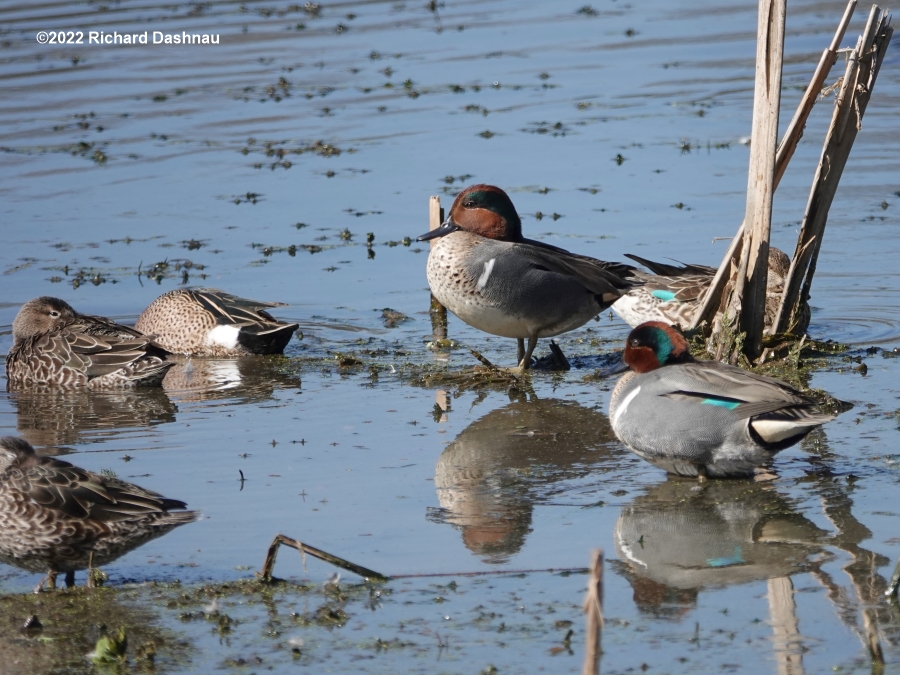
Green Winged Teal 2:41pm
Green Winged Teal 2:41pm
07/25/2021 and 08/01/2021 Sometime
in
May, 2021, there was a vegetation-control spray over Pilant Lake.
This was done to clear the center of Pilant Lake.
The target was probably Giant Cutgrass Zizaniopsis miliacea (aka
Southern Wild Rice) (Alligator Weed (Alternanthera philoxeroides), Water
Hyacinth Eichhornia crassipes)
among others. It was successful, and the center of the lake
cleared nicely. Over the following weeks, dead plants formed mats of
decaying matter. Superficially, they looked
like mud flats. Apparently some birds also thought
so, because BBSP was visited by many species that we usually only
see during times of low water. Black-necked Stilts
(Himantopus mexicanus) were among the visitors. I'm always happy
to see their colors--very dark black contrasted against a brilliant
white. And then there are those amazing long pink
legs--very thin, and almost as long at the stilt's entire body! At
least three families of stilts nested at the park--but pretty far away.
Quite a few folks using cameras with better
reach than mine spent hours trying to capture images of those
families. On July 25, some of the Stilts were a bit closer, so I
tried to capture some images and video. I caught
just one clip that showed a couple of the young birds trying out their
wings. The next week (8/1/21) I was able to watch one foraging much
closer to me, at the Spillway Bridge.
The spillway there is drainage for high water in Pilant
Lake. I also shot
a bit of video ,
which shows the young ones hopping, and the forage on the spillway.
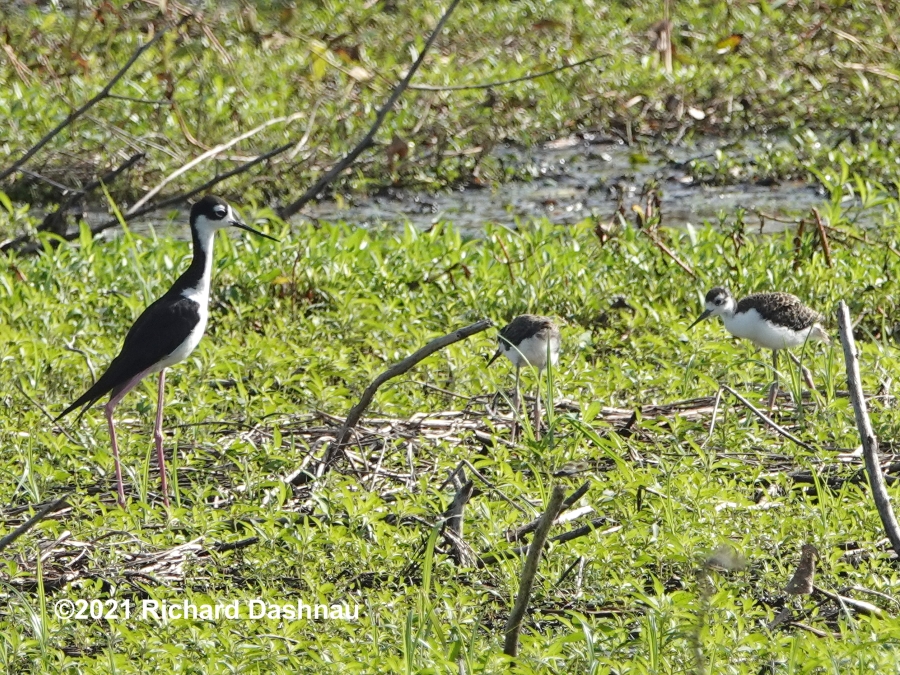
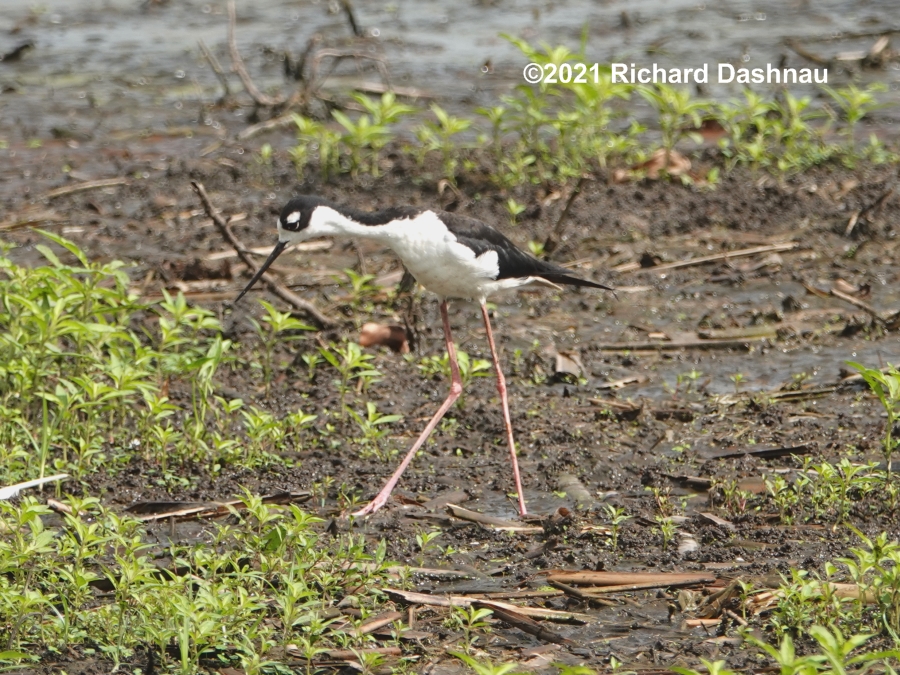
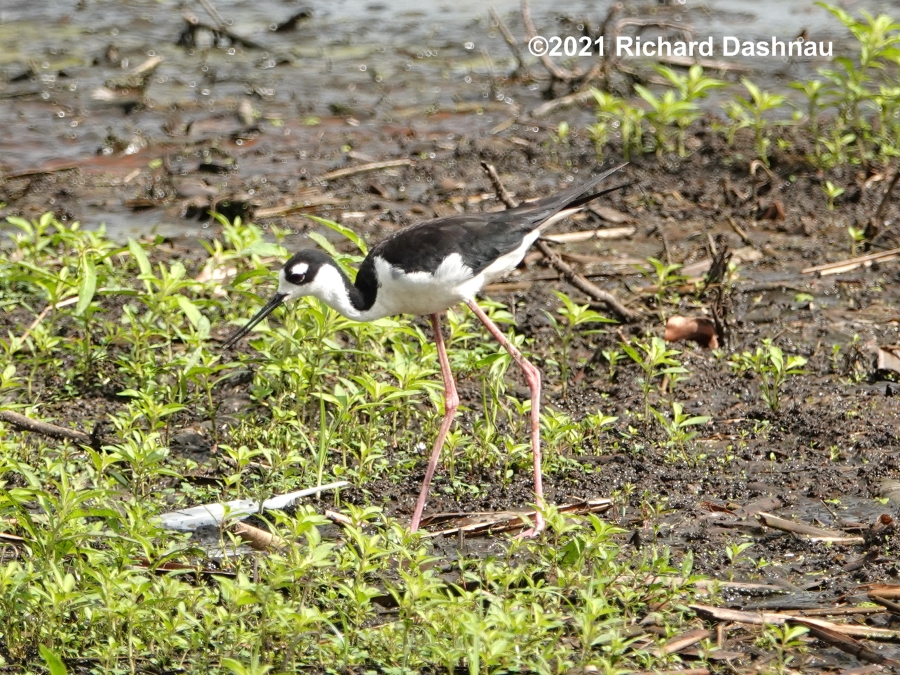
Black-necked
Stilt w/young 7/25/2021
Black-necked
Stilt 7/25/2021
Black-necked
Stilt walked closer 7/25/2021
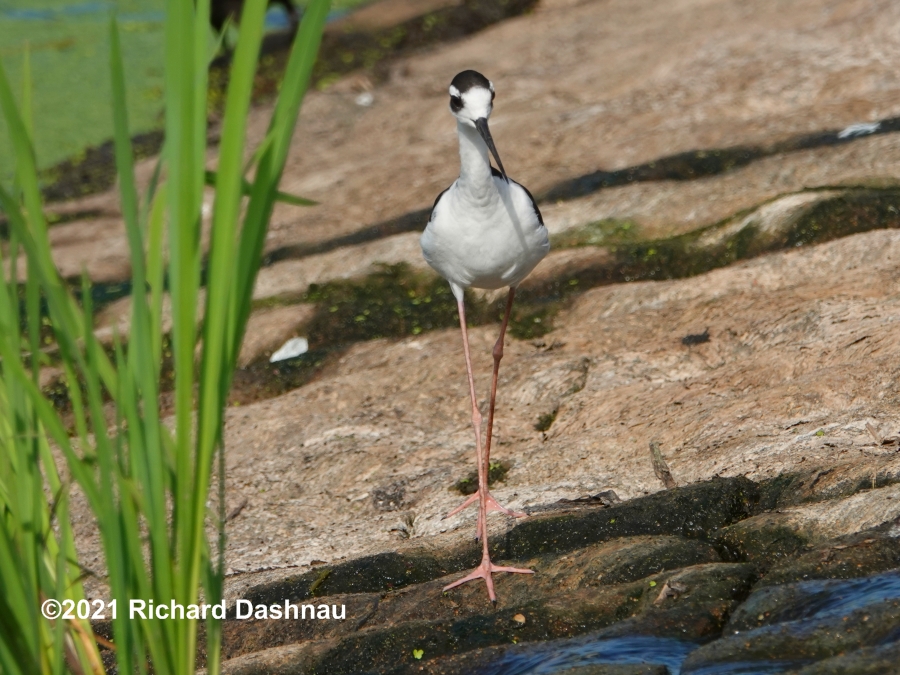
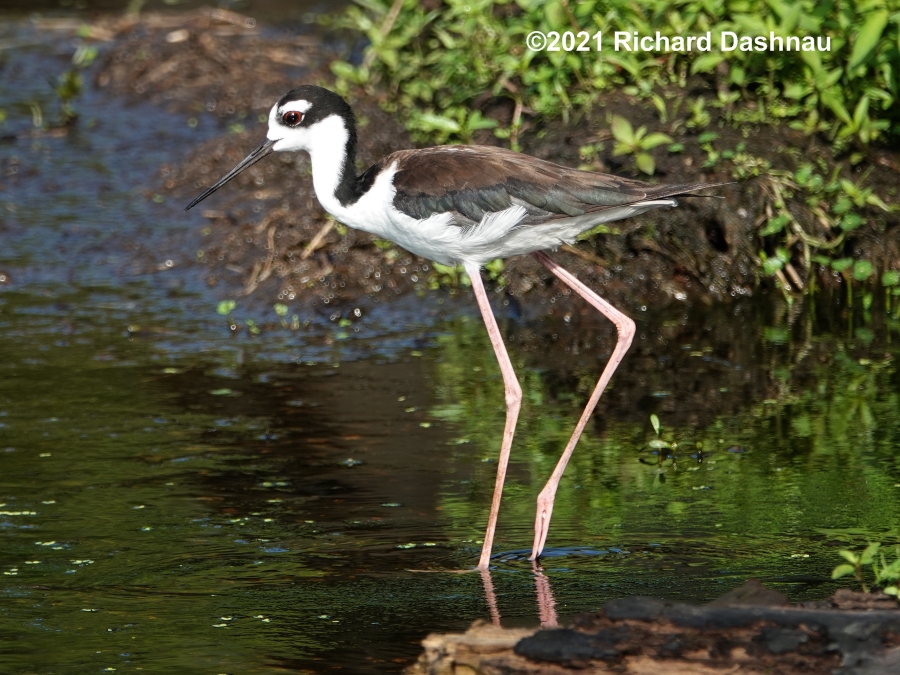
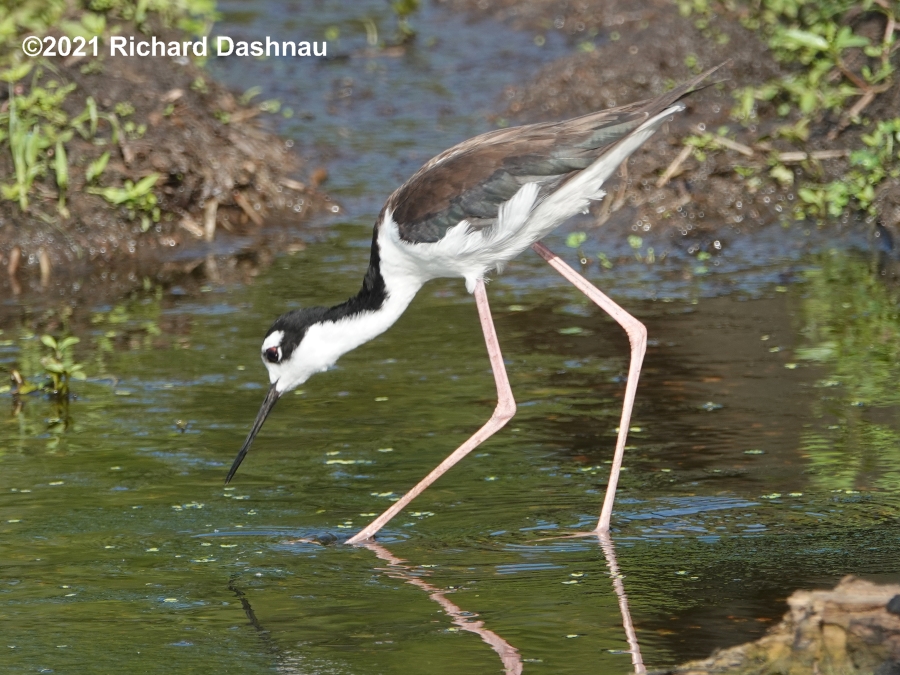
Black-necked Stilt at
Spillway 8/1/2021
Black-necked
Stilt at Spillway 8/1/2021 Black-necked
Stilt at Spillway 8/1/2021
05/02/2021
Even with more "spare time"
it's taking me days to work on new material so I can post it. Part of
the reason is that I get more
new material before I've completed
editing of the previous new material--because I have more of that "spare
time" to go get the new material. Oh, darn. LOL
So, here's how my morning went at Brazos Bend State Park on 05/02/21.
I'd
been standing near an alligator for a while, a visitor had pointed out a
snake (on another page), and about the time I was looking at the snake,
I looked across to the island,
and noticed a pair of Black-Bellied Whistling Ducks (Dendrocygna
autumnalis) on the bird nesting box-I call them "bird boxes" there.
I was able to catch a quick video of one
entering the box. I've done it before, but I'll probably never
tire of seeing this exercise. The diameter of the entry hole in the box
is about the same as the thickness of a
Whistling Duck, and it doesn't have anything to stand on in front of it.
But, the ducks use them, and this video which is slowed 16 times
shows their technique. The image below is
a screenshot from this video clip. NOTE
5/18/21: I have photographed and shot video of this species
many times. While reviewing my web pages today I've discovered that
I
have not ever posted any here--on any of my pages. I'll have to
check again, and post some more. If this is true,then enjoy this first
posting video clip showing the bird box entry.
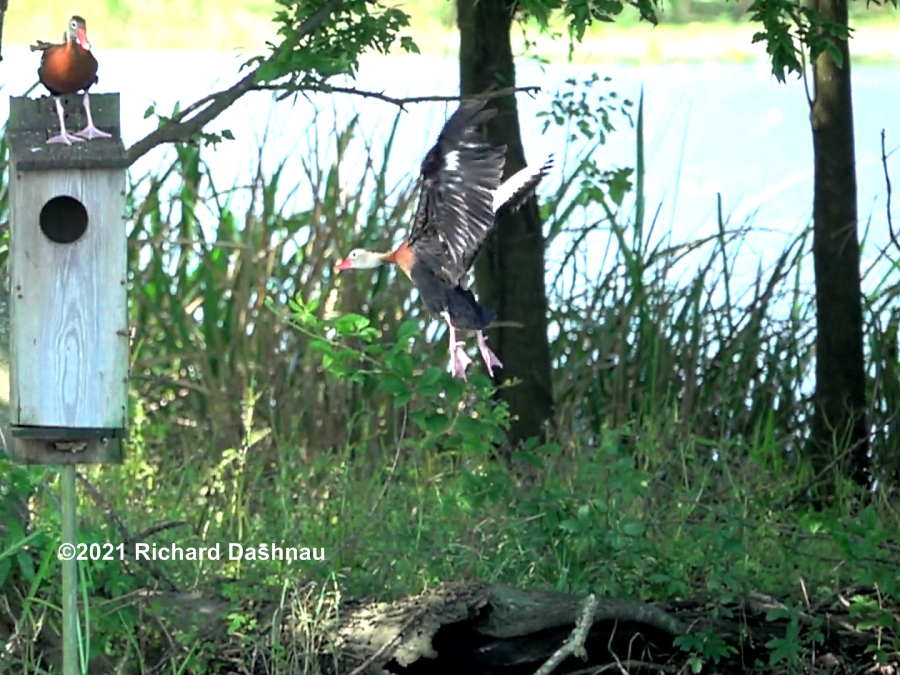
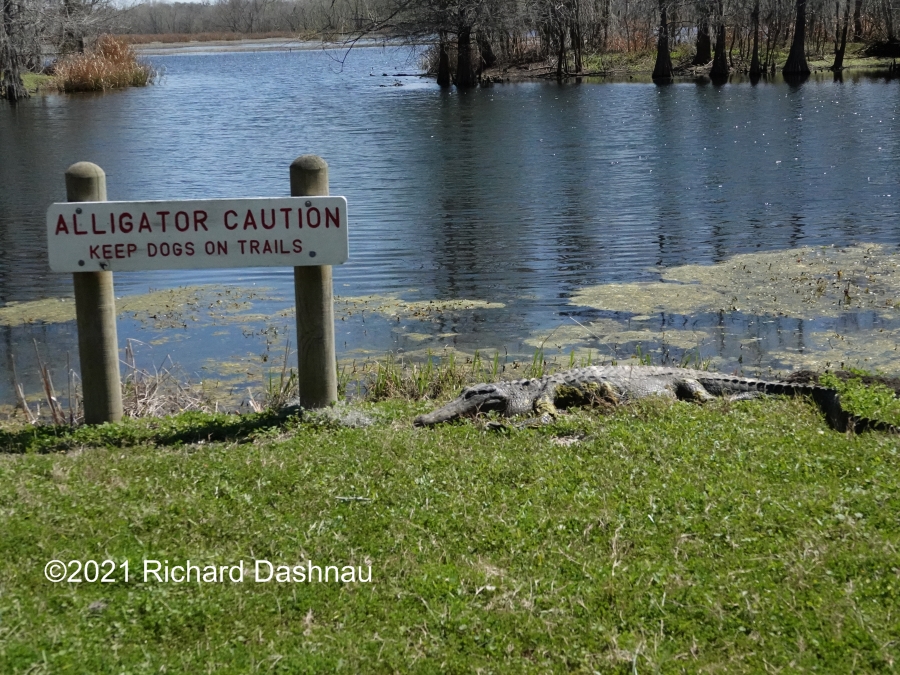
Just pay attention
to the sign, okay?
update 05/23/2020
(material
filmed
10/20/2019) Like
almost everyone these days, I've been staying inside. I
have stopped driving around outside
for...recreational purposes.
BBSP is just too far away, AND, entrance protocol to the park
has changed dramatically (even for volunteers). So...I haven't
been going there. So
I'm catching up on old material.
Wood
Storks
(Mycteria americana) move through East Texas at the the end of
the summer. Sometimes they gather in Brazos Bend State Park. In
2019, I was lucky enough
to be there when the storks came by. I heard that there were
many more there the day before, but at least I saw these. They
were roosted in trees in Elm Lake, and I'd just
gotten there when the remaining Wood Storks took off. I got just
a few pictures, and some short video clips--and then they were
gone; off to the West..
The
video is here.
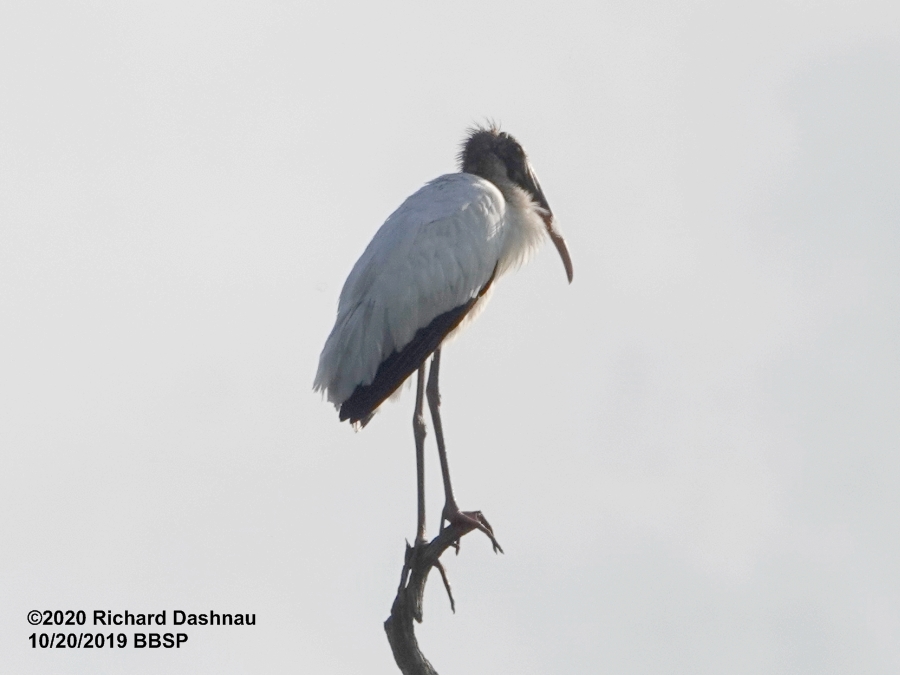
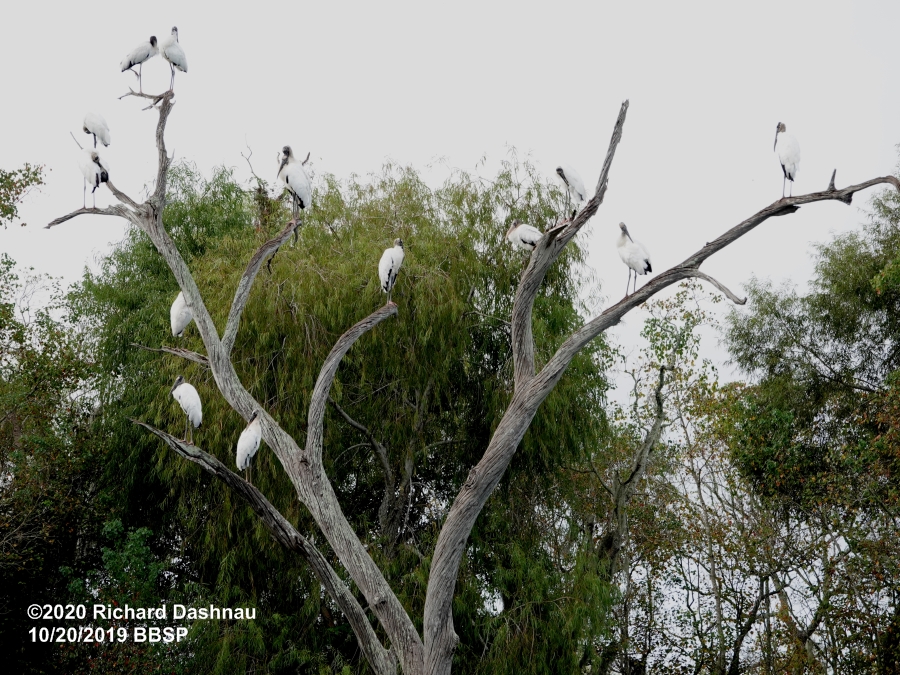
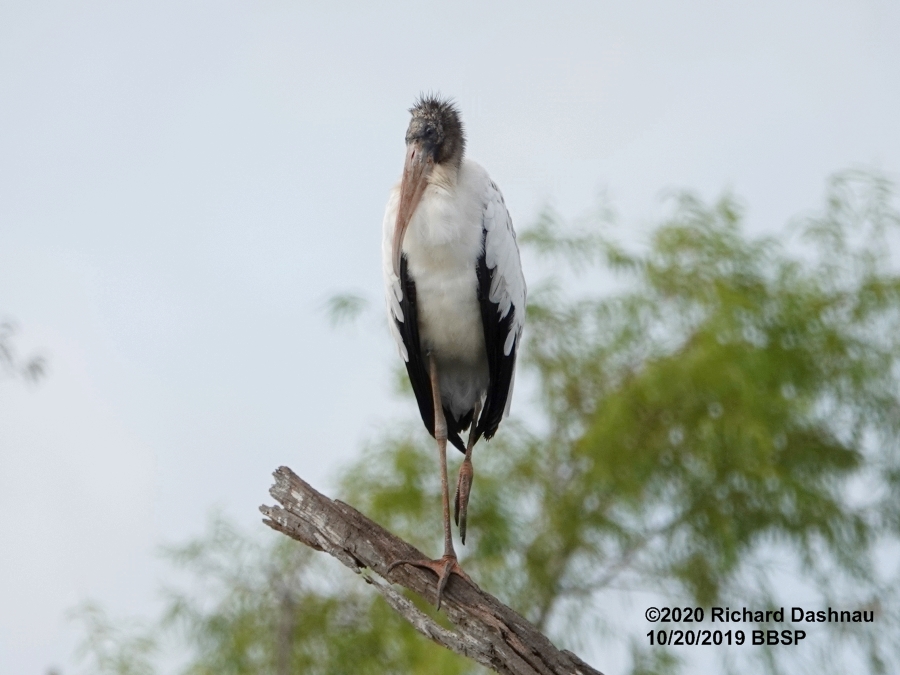
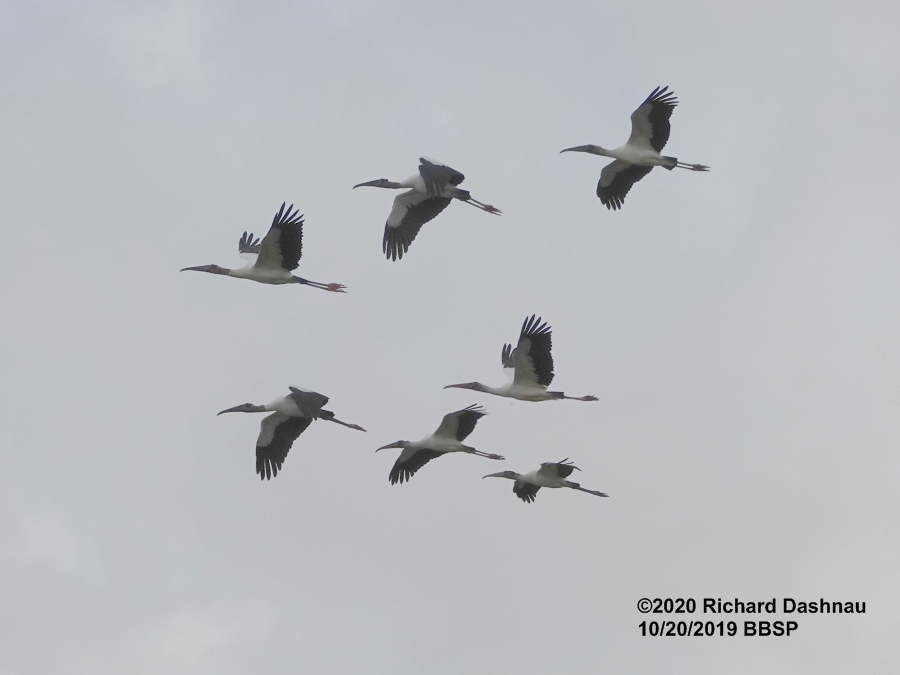
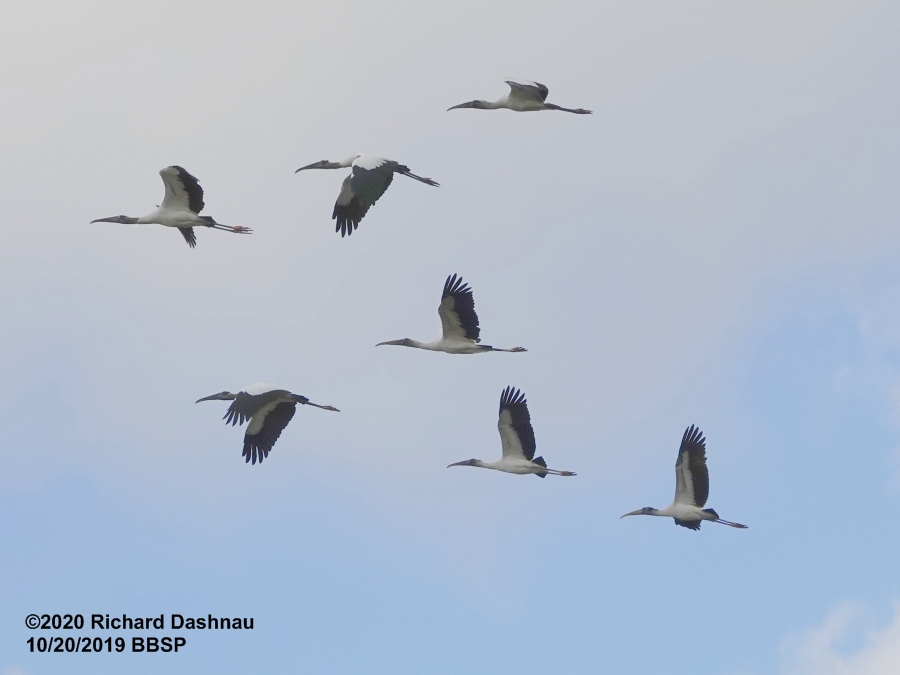
06/17/2018 Birds
(and
other predators) have to hone instinctive hunting behavior to
develop skill. Until they attain that skill, the young animal
can miss, or fall down. Here is a young Cattle Egret
hunting dragonflies. The two images are frame grabs from this video clip.
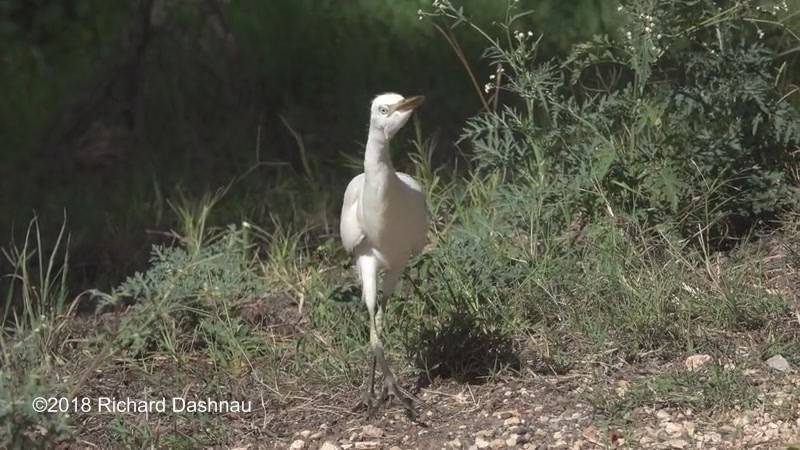
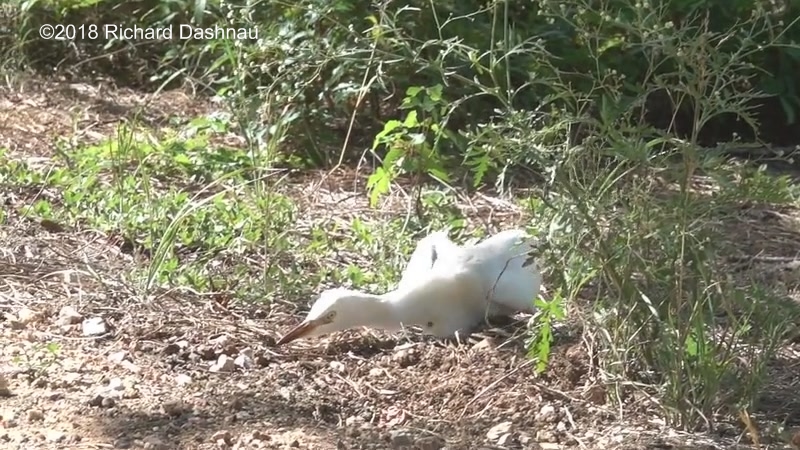
SWAYING TO FOCUS ON A DRAGONFLY
OOPS!
A MISS...AND A TRIP
11/08/2015 I was at the West end of
the Spillway Bridge at Brazos Bend State Park. I'd been watching
some alligators there when I noticed a Snowy Egret fly to a tree
across from
me and apparently try to land on a branch. It seemed to be
struggling, and then I saw a large dragonfly (Probably a Green
Darner) fly out of its beak. I thought that was interesting,
because I thought that the Egret had actually flown after the
dragonfly. So I started watching and filming the Egret when it
returned and landed a bit closer. The Egret was still about
15 yards from me, so I couldn't tell exactly what it was doing.
But, I watched it as it watched the dragonflies that passed by.
A few times, I could see the Egret poised for a strike at
a dragonfly, only to see it relax as the dragonfly moved out of
ranged. Finally, it grabbed a dragonfly, and I caught it on film.
The first image below is a frame grab from the one of the
clips. The second image--the animated gif, is made from the
clip. I've edited the clips together, and that video clip can be
seen here.
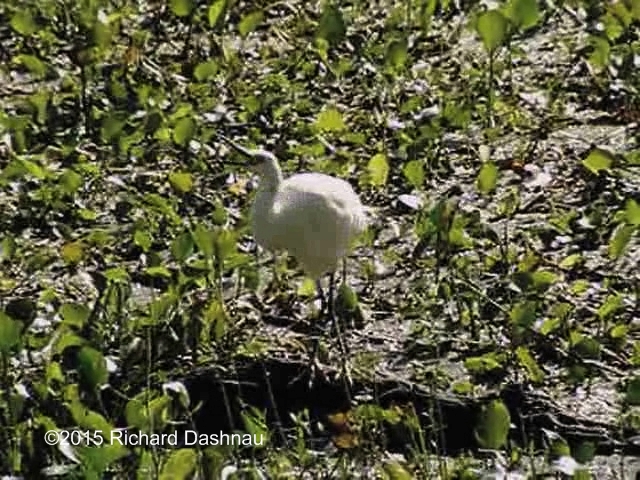 ------------
------------ 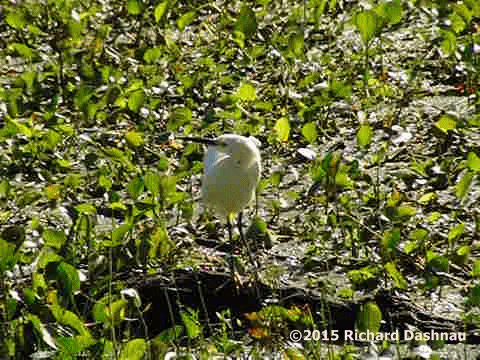 -----------
-----------
Snowy Egrets have bright
yellow feet, which they use to flush prey out from cover as the
bird is wading. The Egret steps forward, and as it puts its foot
down, it gives a quick shaking
motion. But, as shown today, they will pick food out of the air,
or pluck it from cover (that also happens in the clip linked above
.)
January 19 and 26 2014 (This
is material I filmed in 2014, but I'm posting it today, 7/29/2015.)
Groups of Wilson's Snipe (Gallinago
delicata) have been foraging in Pilant Lake
near the Observation Tower. I don't see them there often...but
that could be partly because of their"cryptic" coloration-their colors
allow them to blend in with their surroundings.
They are usually shy, but on these two weekends, the Snipe foraged
closer to the trail. The Snipe use their long, thin bills
as a probe-they plunge it into the mud to look for prey.
They move so quickly, they resemble sewing machines as they walk
along. I tried shooting some digital zoom shots...and then shot
some video at high-speed, about 120
frames per second. While I was watching the Snipe
on the 19th, I noticed that two of them seemed to be displaying at
each other. I shot video of most of one "confrontation".
The exchange between the birds lasted about 5 minutes, and then
they seemed to relax when they moved far enough apart.
Various reference sources group the Snipe with "sandpipers".
Wilson's Snipe was defined as a species separate from the Common
Snipe in 2003
(at least according to Wikipedia), so items published on or before
that time may not have this species defined. My Sibley's Field
Guide to Birds of Eastern America
has them, on page 165. The light-colored stripes on its back
help identify this bird as a Snipe.
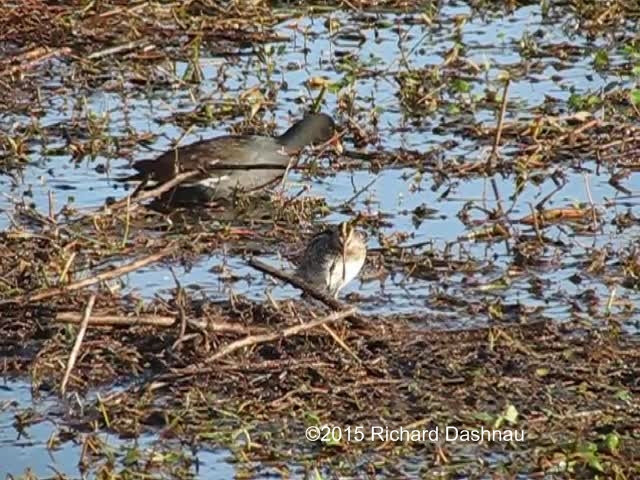
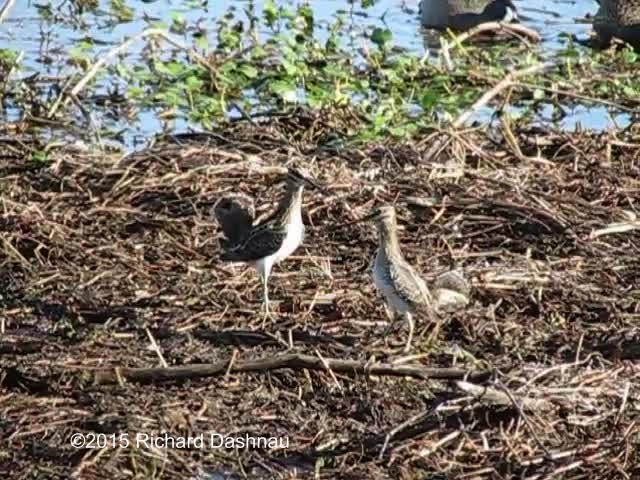
Snipe
scratching its head, video here
(mp4). Video of 2 Snipe facing-off is here
(mp4).
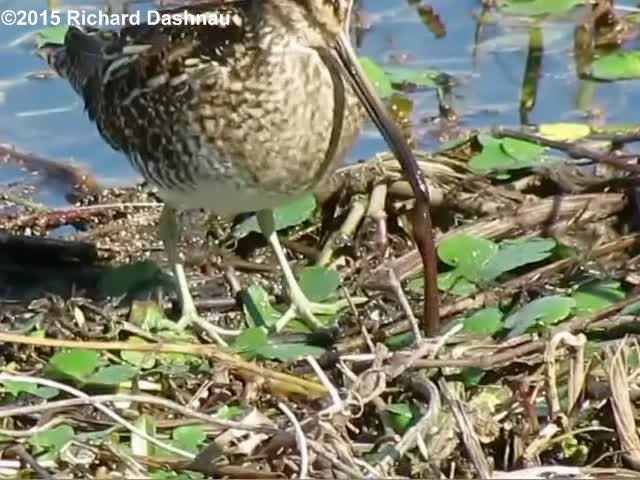
Finally, video
of a Snipe finding and "playing tug-of-war" with an earthworm is
here
(mp4).
And
some photos are below.
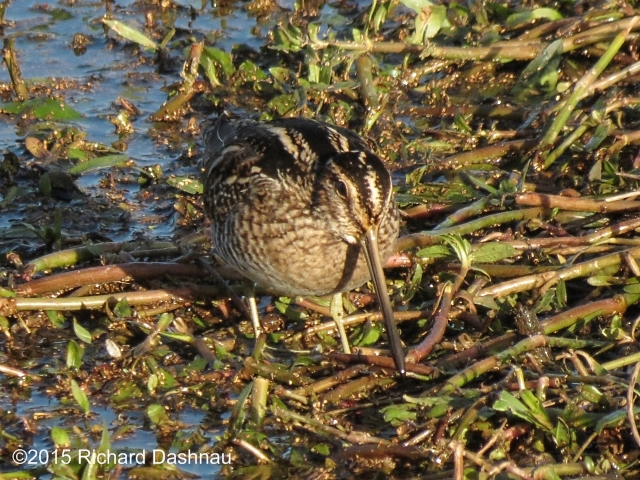 --
--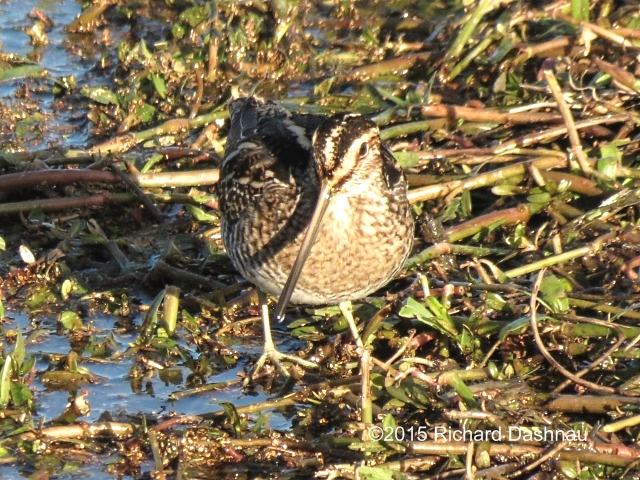 -
-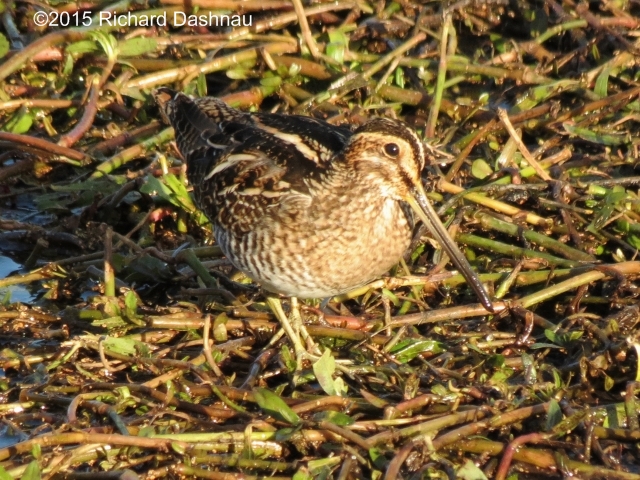 --
--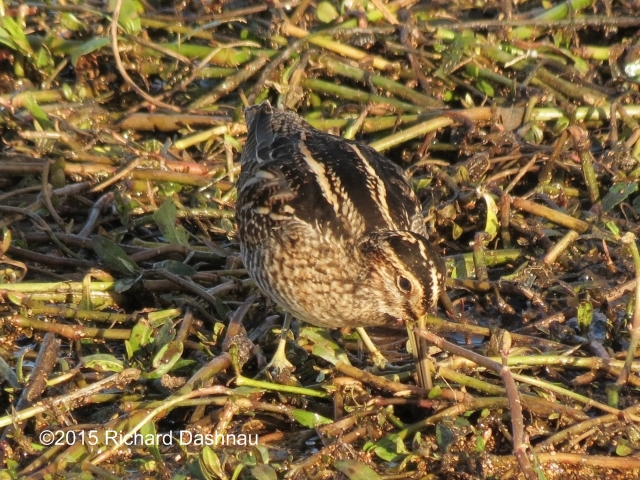
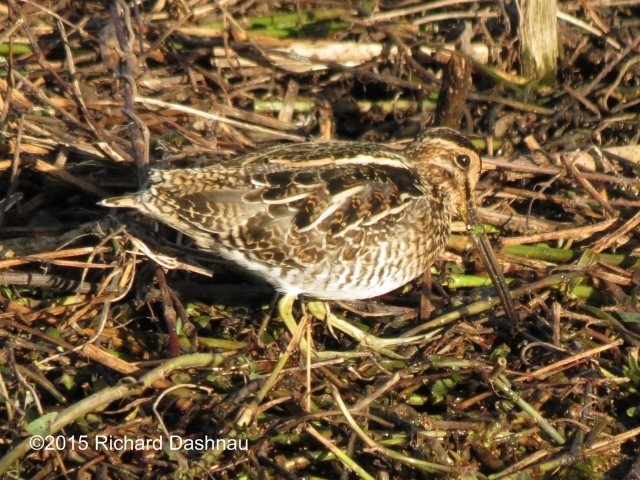 --
--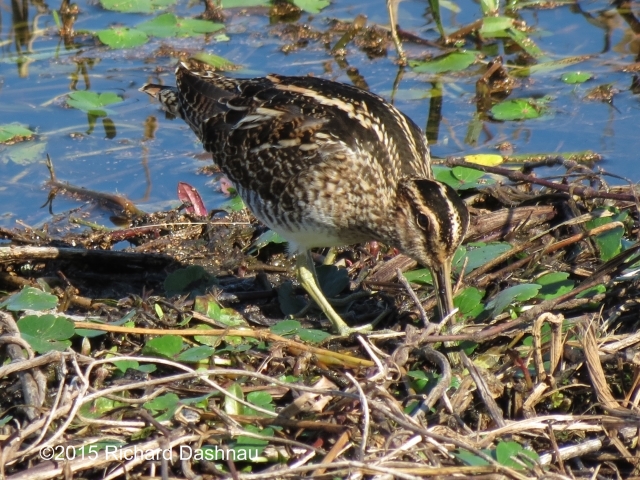 -
-
December 22, 2013 (added 11/21/2015) Wading Birds hunt in many ways,
and catch and eat all kinds of prey. Snowy Egrets are no
exception, but they have a unique tool-their bright,
yellow feet! Although Snowy Egrets (Egretta thula) will ambush
prey, or chase it, they also walk slowly in shallow water with
odd, vibrating steps. They are shifting their bright feet through
the
mud and material under the surface and flushing out
prey--which they can snap up. This video
clip (MP4) shows a Snowy Egret hunting with this method. I
filmed clips at normal speed (30 fps)
and at high speed (120 fps--for slow motion playback at 30fps) and
edited them together. The image below is a frame grab from one of
the clips.
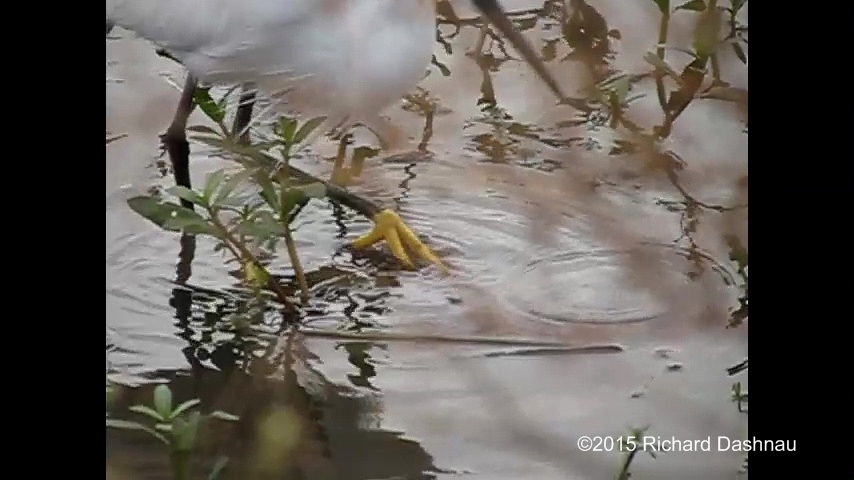
December 26, 2010 The three images below are frame captures from video
clips I shot that morning, and which I edited into this movie
clip
(25 mb).
The morning of Sunday,
December 26, 2010, had temperatures low enough for a skin of ice
to be on low, shaded water, and frost shaped by the shade of
the rails on the Spillway Bridge.
Although the sun came out, the air didn't get much above 45
degrees. The day was cold--at least by Brazos Bend State Park
standards. I was out on the trails anyway, looking for
Eagles
and Otters. I couldn't find either one. While I was at 40 Acre
Lake, I noticed a Crow hovering near the surface of the water next
to one of the islands. Then, I saw a Great Egret doing the same
thing. It would hover close to the surface of the water, and
sometimes stab down with its beak. Occasionally I thought I saw
something splash under the surface. I assumed that the Egret was
harassing Pied-Billed Grebes if they surfaced with prey. I've seen
this before, and figured that's what was going on. I decided to
try to film this activity. First, I tried to follow a Grebes as
they
dove and surfaced--but it's difficult to see where they are going
to surface. So, I decided to watch and film the Egret
instead. I shot a few high speed clips of the Egret taking off,
hovering,
and stabbing the water. After reviewing these, I couldn't tell if
the Egret was stealing from a Grebe or not. I never noticed a
Grebe surface from where the Egret grabbed a fish.I edited
together
some of these clips, so I could watch this magnificent Great Egret
hovering and flying in the early afternoon sun. I hope you enjoy
it as well. A couple things really caught my attention.
First,
the shadow of the Egret's head and neck as it shows on the wings.
Then, the effort of the Egret as the wing beats keep it airborne
at such low speeds.
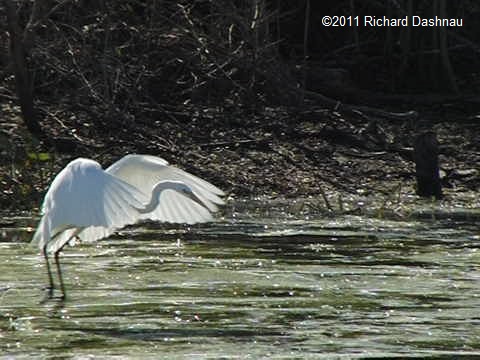 --
--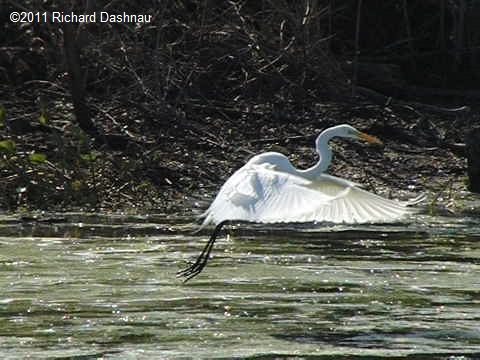 -
-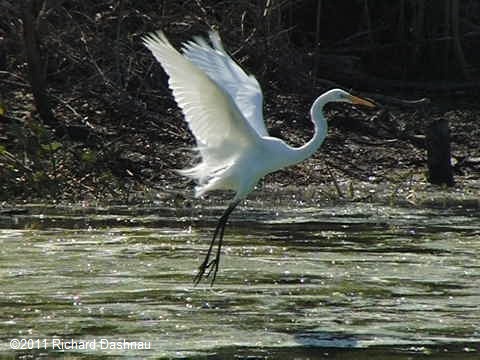 -
-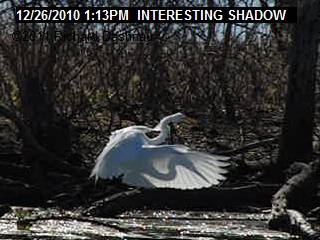
GREAT EGRET
HOVERING 1
GREAT
EGRET HOVERING 2
GREAT
EGRET HOVERING 3
THE
SHADOW!
08/06/2006--BBSP
finally got some rainfall about 4 weeks ago. There was enough
water in Pilant Lake to allow some filling of 40 Acre Lake by
opening the floodgate between them.
When the water levels equalized, the gate was closed, and a
diesel-fueled water pump was set up to continue filling the lake.
The first image below (FILL THAT LAKE!) shows the pump in
action. The
two images below show the improved appearance of the lake.
Compare them with the two images from 06/18/06 further down on
this page.
---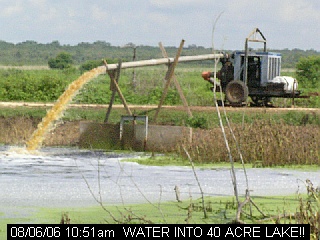 ---
---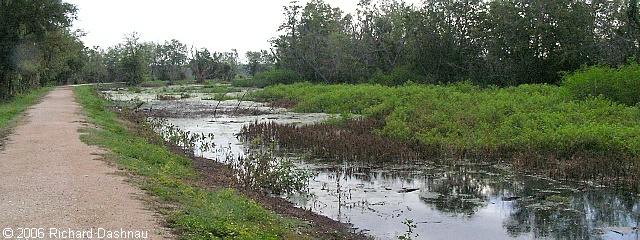 ----
----
FILL
THAT
LAKE!
BETWEEN HOOT'S BENCH
AND OBSERVATION
TOWER

NEAR THE OBSERVATION
TOWER
That's some improvement,
right? This
changed over 4 weekends. Many of the animals that live in the lake were taking
advantage of the water, and the food that was growing. In an
odd turn of events, the primary water level rise (from opening the
floodgate) caused many of the larger fish remaining in what
was left of 40 Acre Lake to die. General opinion is that
there was an oxygen depletion (perhaps caused by silting). Only
the larger fish were affected, as there were many, many
small fish remaining. On the morning of August 6, I stood on
the 40 Acre Lake fishing pier, and watched a group of Great
Egrets catching fish. They were soon joined by a number of
alligators. I thought it interesting that although an
alligator
occasionally swam towards an Egret, it didn't seem to be
interested in catching the bird. Instead, the alligator seemed to
be watching the area around the Egret--perhaps looking for
fish the Egret had dropped, or for fish that it learned would be
near a hunting bird. On the other hand, sometimes (less frequently
than the first case) an Egret would go near an alligator,
and they would both be facing the same spot in the water.
Perhaps the Egret was watching for fish disturbed or distracted by
the alligator's passage. The series of images below are
single frames from some short video clips. The first
clip
4519 KB (OOPS...), starts with an Egret trying to un-spear a
fish...which it drops. Then it seems to be looking straight at me
(I was at least 20 yards away) like it's MY fault that it dropped
breakfast. Then the camera pulls back and pans across to show the
group of Egrets (and one Great Blue Heron). The
splashing sound in the clip is from alligators pouncing.
---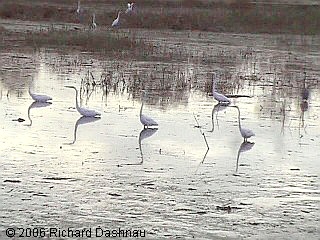 -
-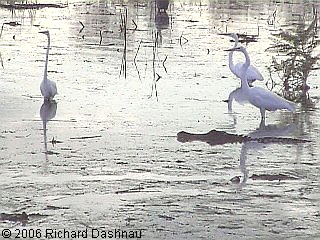 -
-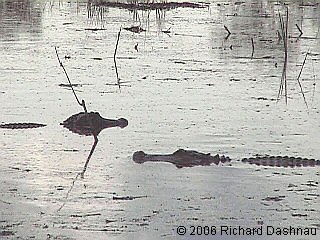 -
-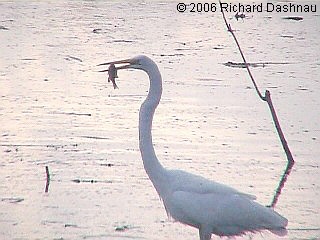
OOPS, AND SLOW
PAN ACROSS
PARDON ME, EXCUSE ME
HEY!,
CATCHING ANYTHING?
HOW A PRO DOES IT
VIDEO
CLIP 4519 KB
VIDEO CLIP
14,621 KB
VIDEO CLIP 4027
KB
VIDEO CLIP 9035
KB
The next
clip
14,621 KB (PARDON ME...) shows a larger alligator as it
swims through the group of Egrets. Notice how each Egret steps
aside very delicately as the alligator approaches--except
for one, which makes a short hop of a few feet. It landed in the
path of the alligator though, so still has to step aside. By the
end of the clip, the alligator has gone near two other alligators.
One of
these, then another, pounces, but without apparent success.
The next
clip 4027 KB (CATCHING ANYTHING?) is a closer view of two
alligators passing. One does a sideways snatch after the
passing, while the other one passes some Egrets.
The final
Egret clip 9035 KB (HOW A PRO...) shows a successful catch
and swallow. Notice how the Egret repositions the slippery fish
before
tossing it that final time and swallowing the fish. I think
the number of Egrets, and Alligators hunting; and the large number
of fish are good indications that the lake will have a good
population
of fish before long.
June 25, 2006--This is actually one of my later sightings of this
striking bird. The first time I noticed one was a few weeks
earlier, on 5/28/06. I was walking along the North side of the
40 Acre Lake trail when I
saw this amazing black-and-white bird. Something about the
colors, or the way they are arranged pleased me, and I stopped
immediately and just watched the
bird. When I returned to
the VC/NC, I described the bird to Beth, and she immediately
identified it as a Black-Necked Stilt. The Black Necked Stilt (Himantopus
mexicanus) is not common
to Brazos Bend
State park, but has started feeding there because the water level
at the lakes has dropped so much. Stilts eat water insects
and even snails, according to The Encyclopedia
of American Birds,
by Michael Vanner.Since I liked them so much, I tried to take pictures
when I could get close enough. They seemed rather shy. Eventually,
there were young Stilts walking
around.Below, I have some pictures and
links to video clips of these interesting-looking birds. Look how
long their legs are, and watch that odd "sitting" position they
attain by bending their legs and
resting on the their
shins.
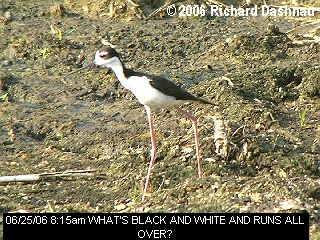 -
-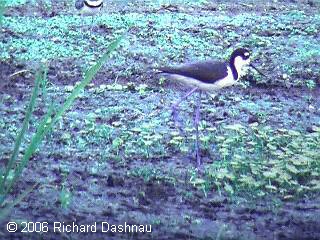 -
-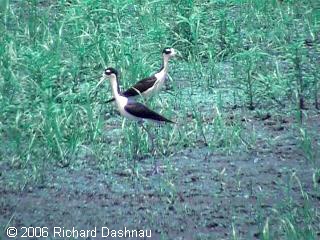
5/28/2006
6/04/2006
5\28\06
clip 5800 kb wmv 6\04\06
clip
pt1 2800 kb wmv 6\04\06
clip
pt2 3400 kb wmv
-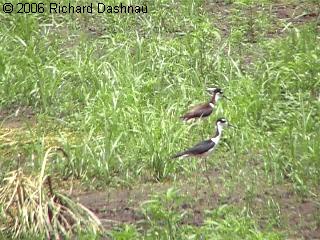 -
-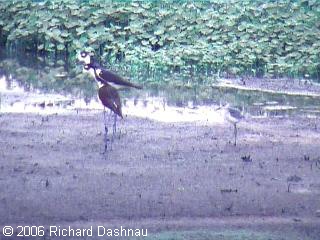 -
-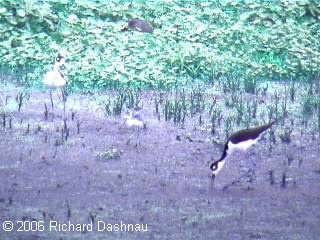
6/04/2006
6/18/06
with alligator
6/18/06 past
alligator-
6\18\06
clip pt1 4400kb wmv 6\18\06
clip
pt2 6200 kb wmv
In the clips from 6/18/06
above, I noticed the alligator only after I'd been watching the
Stilts through the camera for a while. The parent Stilts, however,
appear to be very aware of the alligator.
The Stilts are very protective, and I like how the two
parents walked--in the last clip--along with the young one between
them. Below,
I have some pictures and more pictures from photographs
(those above are frames from video clips) . The first one shows
the two adult Black-Necked Stilts with the young one, and the
alligator behind them, taken on 6/18/06. The remaining 4 show
the
young Stilt with the parents walking around on what used to be the
bottom of 40 Acre Lake.-----------------------------
--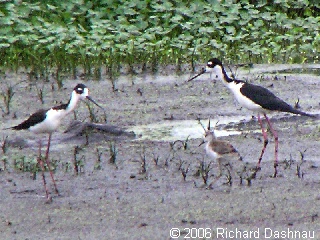 --
--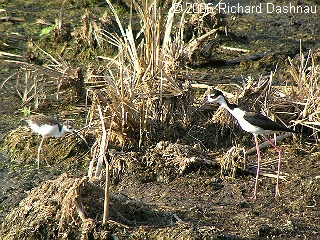 --
--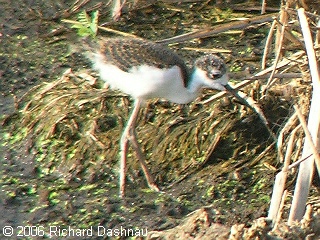
JUST KEEP GOING,
YOUNG'UN
PARENT AND
YOUNG
CLOSEUP
OF YOUNG
-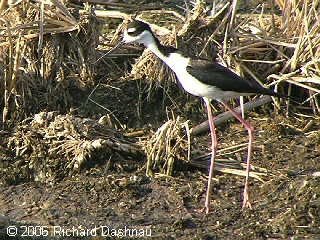 --
--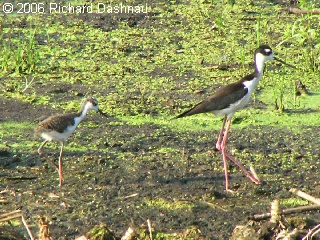
THE PARENT STILT
ADULT AND CHILD WALKING
Those Stilts were walking
on mud that alligators were swimming over just a few
months ago. The alligator with the Stilts above was forced to push
its way through that muck. This must tire
the alligators, plus it makes foraging difficult.
Go back to my
home page, Welcome to rickubis.com
Go back to the
RICKUBISCAM page.
Go back to the See
the World page.




































 --
-- -
- --
--
 --
-- -
- 
 --
-- -
- -
-
 ---
--- ----
----

 -
- -
- -
-
 -
- -
-
 -
- -
-
 --
-- --
--
 --
--